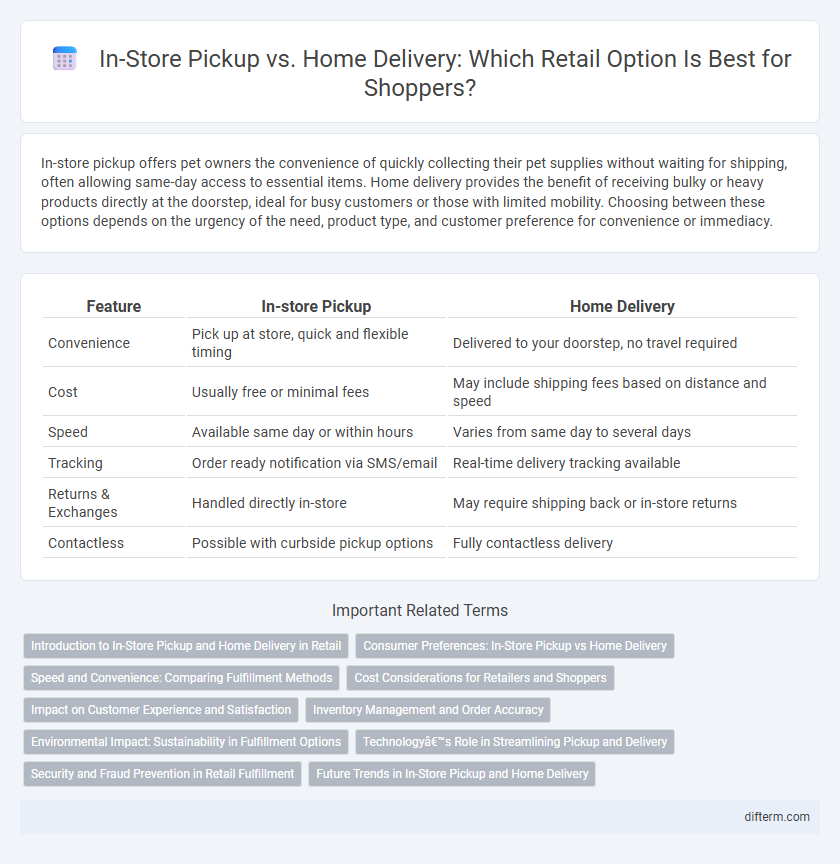In-store pickup offers pet owners the convenience of quickly collecting their pet supplies without waiting for shipping, often allowing same-day access to essential items. Home delivery provides the benefit of receiving bulky or heavy products directly at the doorstep, ideal for busy customers or those with limited mobility. Choosing between these options depends on the urgency of the need, product type, and customer preference for convenience or immediacy.
Table of Comparison
| Feature | In-store Pickup | Home Delivery |
|---|---|---|
| Convenience | Pick up at store, quick and flexible timing | Delivered to your doorstep, no travel required |
| Cost | Usually free or minimal fees | May include shipping fees based on distance and speed |
| Speed | Available same day or within hours | Varies from same day to several days |
| Tracking | Order ready notification via SMS/email | Real-time delivery tracking available |
| Returns & Exchanges | Handled directly in-store | May require shipping back or in-store returns |
| Contactless | Possible with curbside pickup options | Fully contactless delivery |
Introduction to In-Store Pickup and Home Delivery in Retail
In-store pickup enables customers to order products online and collect them directly from a physical store, reducing shipping costs and wait times. Home delivery offers the convenience of receiving purchases at the doorstep, appealing to consumers seeking hassle-free shopping experiences. Retailers optimize operations by balancing inventory management, customer preferences, and logistical efficiency between these two fulfillment methods.
Consumer Preferences: In-Store Pickup vs Home Delivery
Consumer preferences in retail show a strong inclination toward the convenience of in-store pickup for immediate product access and avoiding shipping fees, whereas home delivery appeals due to its time-saving benefits and contactless experience. Retailers report that 62% of shoppers favor in-store pickup for groceries and electronics, citing control over order timing as a key factor. Conversely, 48% of consumers prefer home delivery for bulky or high-value items to minimize physical effort and leverage home convenience.
Speed and Convenience: Comparing Fulfillment Methods
In-store pickup offers faster order retrieval by eliminating shipping time, enabling customers to collect purchases within hours. Home delivery provides convenience by bringing products directly to the customer's doorstep but may involve longer wait times due to shipping logistics. Retailers optimize fulfillment strategies by balancing speed and convenience to enhance customer satisfaction and reduce operational costs.
Cost Considerations for Retailers and Shoppers
In-store pickup reduces shipping expenses and packaging costs for retailers while minimizing logistical complexities and last-mile delivery fees, resulting in potential savings that can be passed on to shoppers. Home delivery incurs higher operational costs due to transportation, fuel, and labor, which often leads to additional delivery fees for consumers. Retailers must balance these cost factors with customer preferences to optimize profitability and satisfaction.
Impact on Customer Experience and Satisfaction
In-store pickup enhances customer experience by offering immediate product access and reducing shipping costs, leading to higher satisfaction among convenience-seeking shoppers. Home delivery provides the advantage of effortless shopping and doorstep convenience, significantly benefiting customers valuing time-saving and comfort. Retailers optimizing seamless communication and timely updates for both options can maximize overall customer satisfaction.
Inventory Management and Order Accuracy
In-store pickup enhances inventory management by allowing retailers to allocate specific stock for local fulfillment, reducing the risk of overselling and improving real-time inventory tracking. Home delivery demands precise coordination between warehouse inventory and shipping logistics to maintain order accuracy and minimize fulfillment errors. Optimizing both methods involves integrated inventory systems that synchronize stock levels across online and physical channels, ensuring accurate order processing and customer satisfaction.
Environmental Impact: Sustainability in Fulfillment Options
In-store pickup reduces carbon emissions by consolidating deliveries and minimizing last-mile transportation, lowering the retail supply chain's overall environmental footprint. Home delivery often involves multiple trips and packaging waste, increasing energy consumption and contributing to pollution. Choosing sustainable fulfillment options like store pickup supports retailers' goals to decrease greenhouse gas emissions and promote eco-friendly shopping practices.
Technology’s Role in Streamlining Pickup and Delivery
Advanced technology solutions such as real-time inventory management systems and AI-powered routing optimize in-store pickup and home delivery processes, reducing wait times and enhancing customer satisfaction. Mobile apps with integrated order tracking and contactless payment streamline the customer experience, ensuring seamless coordination between retail locations and delivery drivers. Data analytics further improve operational efficiency by forecasting demand and managing workforce allocation effectively.
Security and Fraud Prevention in Retail Fulfillment
In-store pickup enhances security by minimizing shipping risks and allowing direct identity verification at the point of collection, reducing fraud occurrences. Home delivery relies heavily on secure packaging, tracking systems, and address verification to prevent parcel theft and delivery fraud. Retailers must implement robust authentication methods and real-time monitoring to safeguard both fulfillment options effectively.
Future Trends in In-Store Pickup and Home Delivery
Future trends in in-store pickup emphasize seamless integration with mobile apps, enabling real-time order tracking and contactless transactions to enhance customer convenience. Home delivery is evolving through AI-driven route optimization and autonomous vehicles, reducing delivery times and operational costs for retailers. Both methods are increasingly incorporating sustainable packaging solutions to meet consumer demand for eco-friendly shopping experiences.
In-store Pickup vs Home Delivery Infographic

 difterm.com
difterm.com